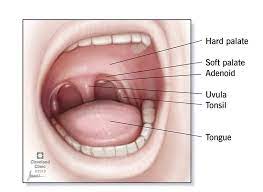
Overview
Adenoidectomy is a surgical procedure used to remove adenoid glands when they become swollen or enlarged due to infections or allergies. Enlarged and inflamed adenoids are known as adenoiditis, this makes breathing difficult and causes respiratory infections.
Adenoid glands are situated behind the nose at the roof. It is a mass of lymphoid tissue (which appears as a small lump of tissue) behind the nasal passage. Adenoids serve an important purpose in young children, as they act as a part of the immune system and protect the child’s body from bacteria and viruses.
Removing adenoid glands can help the patient to breathe easily and sleep more comfortably. Adenoids automatically shrink around the age of 10-11 years and are completely gone by the teenage years.
When is Adenoidectomy surgery needed?
A patient needs adenoidectomy surgery when their adenoids gland becomes enlarged, which can partially or completely block the airway. Patients with enlarged adenoids can have breathing problems, infections, and other complications which may lead to snoring problems or conditions such as sleep apnea.
It can cause complications such as chronic nasal drainage, sinus infections, frequent ear infections, or fluid in the ear which can lead to temporary hearing loss. A patient with enlarged adenoids, who is not responding to medical treatment needs immediate attention to remove adenoids through surgery and prevent complications that can have long-term effects.
A patient needs adenoidectomy surgery when:
- Antibiotics do not clear ear infections
- Buildup in fluid in the ear due to adenoid swelling
- When dentition and oral hygiene starts getting affected
- Sleep apnea or snoring
Diagnosis
A patient with enlarged adenoids glands can have breathing problems, ear infections, and recurring sinusitis. A doctor will check the symptoms, and patient’s health history and examine the adenoids by placing a small camera in the patient’s nose. The doctor may also recommend imaging tests such as x-ray to examine the adenoids.
Based on symptoms and physical examination of the ears, nose and throat, doctors may recommend adenoidectomy.
Treatment
Adenoidectomy is a short surgical procedure performed by an ENT surgeon (ear, nose, throat specialist). The procedure takes about 20 to 30 minutes on an average.
General anesthesia is given to the patient before the surgery. The anesthesiologist combines the mixture of gas and intravenous medication for general anesthesia. This is given through the mouth and it keeps the patient asleep during the surgery.
The process of adenoidectomy:
- The surgeon places a small tool inside the mouth to keep it open
- Adenoids glands are removed using a debrider/coblator under endoscopic guidance
After surgery, the patient is taken into the recovery room until he or she awakens from the anesthesia. There are no scars or stitches involved in this surgery.
Taking Care of the patient after Surgery
After an adenoidectomy, a patient experiences mild pain and discomfort including sore throat, bad breath, and running nose. Taking proper care can prevent complications. A parent can take care of the child by:
- Giving prescribed pain medicines on time
- Offering plenty of water and other fluids to drink to stay hydrated
- Giving soft foods such as pudding, soup, or mashed vegetables to soothe the sore throat
- Avoiding hot and hard food and only give a light and soft diet during recovery
- Avoiding nose-blowing, or any other rough activity and sports
- Applying an ice pack on the neck to reduce swelling
- Have the child rest for the first few days
After adenoid removal, with care and medicines, children recover within 4-5 days
The writer is Associate Director & Head ENT(Ear Nose Throat), Max Super Speciality Hospital, Saket, New Delhi.



